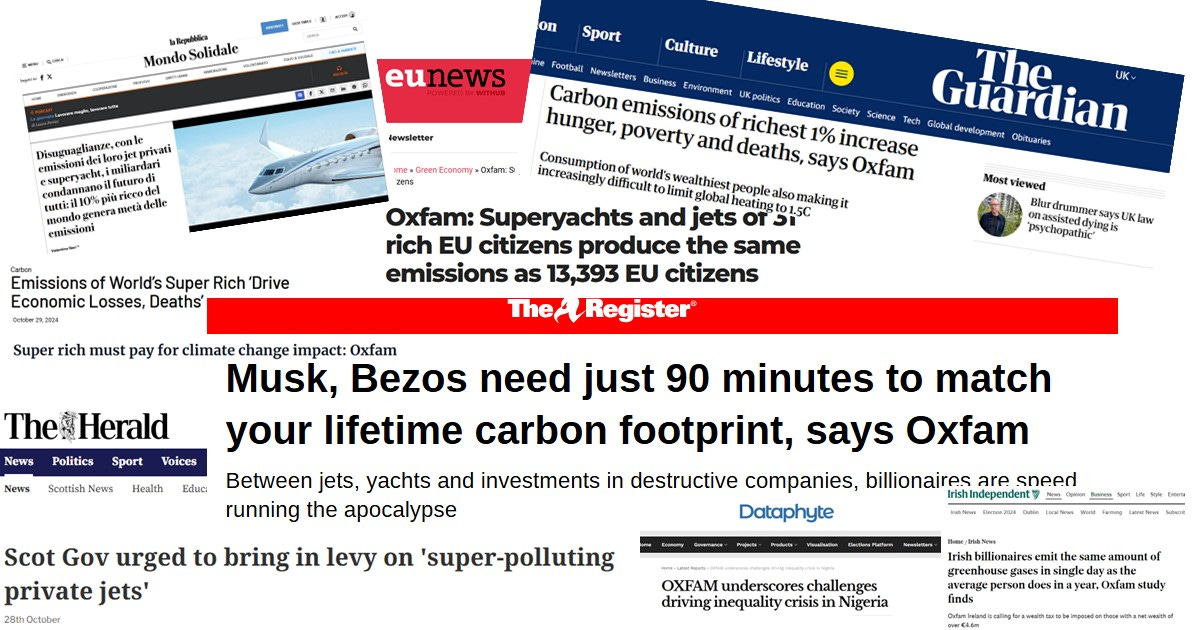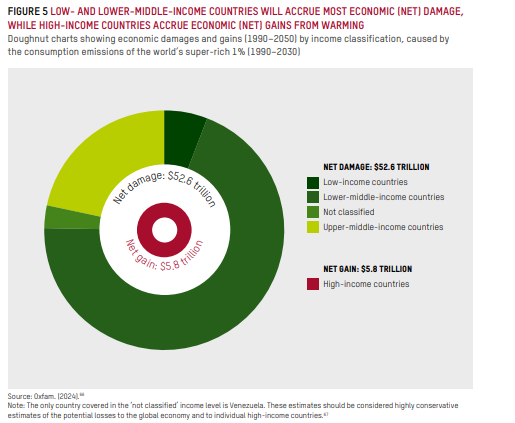Carbon Inequality Kills
Oxfam's latest climate inequality report 'Carbon Inequality Kills' was published ahead of COP29 and exposes the emissions of the super-rich and how they are fuelling inequality, hunger and death.
As COP29 draws closer, for a third year Oxfam investigates the devastating impacts of the emissions of the super-rich with striking headline stats.
In this week’s Bulletin, we look at the numbers behind the new report.
Carbon Inequality Kills in numbers
Why carbon inequality matters. At the current rate, the carbon budget (the amount of CO2 that can still be added to the atmosphere without causing global temperatures to rise above 1.5°C) will be depleted by January 2029. However, if everyone’s emissions matched those of the richest 1%, the carbon budget would be used up in under five months. And if everyone started emitting as much carbon as the private jets and superyachts of the average billionaire in Oxfam’s study, it would be gone in two days.
Emissions of the 1% must drop by 97% by 2030 to keep to 1.5°C; current trends predict just 5% reduction.
Emissions of billionaires
Oxfam’s painstaking, detailed investigation tracked the emissions from the private jets, superyachts and investments of 50 of the world’s richest people over the course of a year. The headline finding was that these billionaires emit more on average in 90 minutes than the average person does in a lifetime.
Addiction to private jets. Billionaires love their private jets. On average billionaire jets spent over 425 hours in the air, travelling the equivalent to circumnavigating the globe 10 times. It would take the average person 300 years to emit the amount of carbon billionaires do from their jets.
Superyachts, the most polluting billionaire toy (except perhaps rocket ships!) Oxfam’s research found that yachts are 3 times more polluting than jets, emitting 850 times more than the average person. The Walton family, heirs of the Walmart retail chain, own three superyachts, emitting as much carbon as around 1,714 Walmart shop workers.
Highly polluting investments. While eliminating yachts and jets is an inequality issue, if they all disappeared tomorrow it wouldn’t put us back on track to the 1.5°C goal.
Through their investments, however, billionaires have huge influence over some of the world’s biggest corporations and are driving us over the edge of climate disaster. The average investment emissions of 50 of the world’s richest billionaires are 340 times their emissions from private jets and superyachts combined. Nearly 40% of billionaire investments analysed in Oxfam’s research are in highly polluting industries (like oil and gas or cement) and on average their portfolio is almost twice as polluting as an investment in the S&P 500.
If these investments were instead in a low-carbon-intensity investment fund, their investment emissions would be 13 times lower.
Devastating consequences of the emissions of 1%
With researchers from Concordia University, Dartmouth College and Columbia University, Oxfam’s research also provides a national and regional breakdown of deaths, hunger and inequality caused by the emissions of the richest 1% (not to be confused with billionaires who are a much smaller subset of this group).
Global inequality. The emissions of the richest 1% have caused global economic output to drop by $2.9 trillion since 1990. The biggest impact will be in countries least responsible for climate breakdown. Low- and lower-middle-income countries will lose about 2.5% of their cumulative GDP between 1990 and 2050.
Hunger. The emissions of the richest 1% have caused crop losses that could have provided enough calories to feed 14.5 million people a year between 1990 and 2023. This will rise to 46 million people annually between 2023 and 2050, with Latin America and the Caribbean especially affected (9 million a year by 2050).
Death. In just four years (2015–2019) the consumption emissions of the world’s super-rich 1% are enough to cause 1.5 million excess deaths between 2020 and 2120. We also found that 78% of excess deaths due to heat through 2120 will occur in low- and lower-middle-income countries.
Watch the brilliant campaign short video here:





